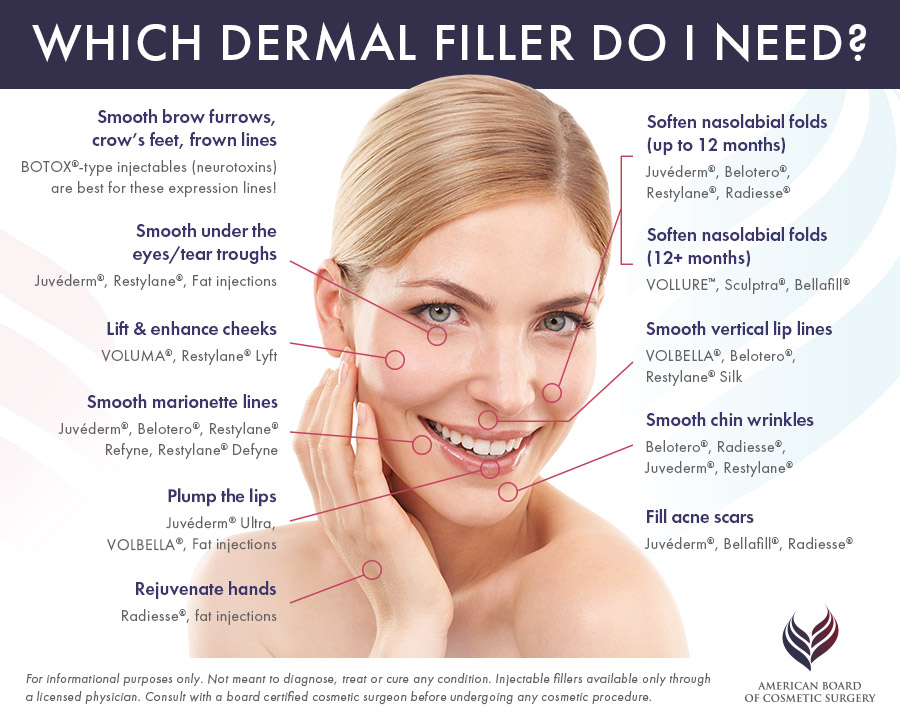Injectable Fillers in New Jersey
Learn about injectable dermal fillers
Did you know that many visible signs of aging can be traced back to volume loss? As facial tissues thin out, lines become etched around the nose and mouth and cheeks look a little hollow. Dermal fillers can replace lost volume to help smooth wrinkles, plump the lips, and restore a more youthful appearance. Learn all about injectable filler treatments below.
What are Injectable Dermal Fillers?
Dermal fillers are gel-like substances that are injected beneath the skin to restore lost volume, smooth lines and soften creases, or enhance facial contours. More than 1 million men and women annually have chosen this popular facial rejuvenation treatment, which can be a cost-effective way to look younger without surgery or downtime.
Which filler do I need?
With so many dermal filler products on the market, it can be difficult to know which option is best for you without an experienced surgeon’s guidance. Each product is uniquely formulated to have a certain texture, density, and injection depth, which means that certain fillers work better for certain areas of concern. While when you meet with our medical staff, we will determine what product is best for you, the following diagram illustrates in general where we tend to apply certain products:

What to Expect During Treatment
Dermal filler injections are non-surgical and typically completed during an office visit. Your initial treatment will begin with a consultation, during which you will meet with Dr. Nusbaum to discuss your concerns and goals.
Pre-treatment consultation
During your consultation, Dr. Nusbaum will evaluate your area of concern and review your medical history. While the risks associated with dermal fillers are minimal, you need to fully disclose your medical history prior to treatment, as certain allergies, skin and neurological conditions, or medications can jeopardize your safety or results. For instance, you need to tell our staff if you have been taking NSAIDs (e.g., aspirin, ibuprofen, naproxen) or blood thinners, as these increase the likelihood of bruising.
Your injectable filler treatment
Just before the actual treatment, the area will be cleaned, and you may be given a topical anesthetic to numb the area prior to injection. Many filler products also contain lidocaine, a mild anesthetic, which is intended to help minimize discomfort during and after your treatment. Dr. Nusbaum will then inject a precise amount of filler strategically beneath the skin.
Depending on the product and the areas treated, you should be able to notice results immediately after receiving filler injections. Some patients experience mild bruising and swelling, but these are temporary and should subside over the days following treatment. You will be able to go back to your normal activities right after treatment, but Dr. Nusbaum may ask you to take the day off from exercise or other strenuous activity.
How Long Do the Results Last?
How long the effects of dermal fillers will last depends on the product, the area of treatment, and the patient. Generally speaking, the denser the product is and the more deeply it is injected, the longer it will last, although this is not a hard and fast rule. To maintain your results, Dr. Nusbaum will simply repeat treatment, adjusting the amount and techniques as necessary to ensure optimal results.
Hyaluronic acid fillers tend to be the most temporary option, and therefore are often recommended for first-time filler patients. These will typically last from 6 to 18 months. Injections to the lips will wear out a little faster than those to the nasolabial folds. Certain HA fillers, such as VOLUMA, are formulated to last longer, but are usually limited to certain areas, such as the cheeks.
Synthetic fillers tend to last longer, as they are not absorbed by the body. They can be a great option for the right patient, but you’ll want to be ready to commit to results that will be there for several years.


